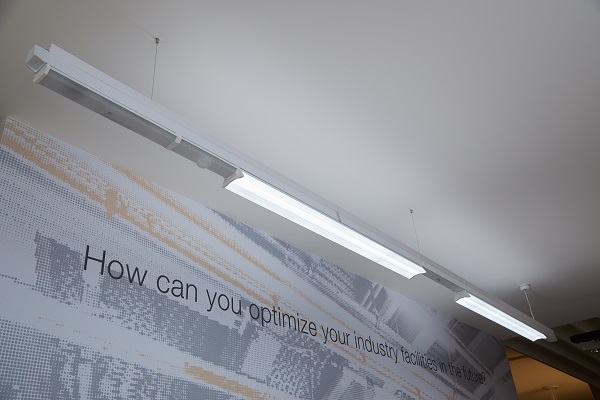Nokia Bell Labs and Osram have teamed up to create the foundation of affordable, high-performance indoor radio networks. In a joint initiative the network specialist and the lighting company have been exploring how ceiling luminaires can be used to create a tightly integrated interior radio network with 5G capabilities. “Our office and industrial luminaires are already networked for remote control,” said Thorsten Müller, Head of Innovation at Osram. “In this R&D project, we equipped them with special broadband radio modules, allowing mobile devices like cell phones and laptops to connect to the luminaire network and transmit data.”
 |
|
Network radio modules being integrated unremarkably into Osram’s Licross luminaires. (Image: OSRAM) |
The new solution is much easier to install than conventional Wi-Fi systems and enables new applications. Ceiling luminaires are installed close together in every building and can be connected to a future light-control and network-management system in office and industrial buildings. This system simply has to be connected to a building’s communication access line, like a fiber optics connection. The concentrated and evenly distributed pattern of installed light sources prevents dead zones from occurring in the building. Affordable radio modules will increase the price only slightly compared to conventional office luminaires. They also perform better and will generate lower costs than Wi-Fi access points and repeaters. In addition these new luminaires can be used for other services like the collection of sensor data.
5G networks represent the next stage in the development of LTE (4G). They enable 5Gcapable end devices to transmit data up to 20 gigabits per second. Typically the frequencies being used limit the reception in buildings. As a result, separate interior room networks are ideal for producing smooth mobile connections to the Internet. Test installations using prototypes of the new radio luminaires have demonstrated that data throughput of well over 100 megabits per second can be reliably achieved with low-priced Wi-Fi transmitters operating at 2.4 gigahertz (GHz). More sophisticated radio modules in which various frequencies are combined and several channels are operated simultaneously currently already facilitate speeds just below the gigabit level. With 5G technology, which uses broader frequency ranges and can transmit more data in them, several gigabits per second can be generated with this solution.
“At Bell Labs, we focus on solving difficult human challenges in our future connected world. Our disruptive 5G innovation brings distributed MIMO (multiple-input multiple-output) radio systems into existing dense lighting arrays, and ‘illuminates’ the entire enterprise with multi-gigabit capacity to solve future needs,” said Peter Vetter, Head of Access Research, Nokia Bell Labs. “Our light installations are getting smarter and smarter,” Osram’s Thorsten Müller added. “Presence detectors in office buildings can already be used to manage meeting rooms more efficiently and plan targeted cleaning as and when required. In retail stores, customers can be better addressed with the help of localized digital services.”
The newly developed radio luminaires can be integrated into Osram’s recently announced Internet of Things (IoT) platform Lightelligence as supplemental sources of sensor data. Lightelligence can be used to bundle all smart components, applications and programs. The results are new applications and services that extend far beyond light. Osram’s sensor-based logistics solutions, for example, can use a warehouse’s lighting infrastructure to record inventories, monitor temperature and humidity for perishable goods and optimize the way in which warehouses are used. The system is open for the integration of all manufacturers’ products, programs and interfaces.












